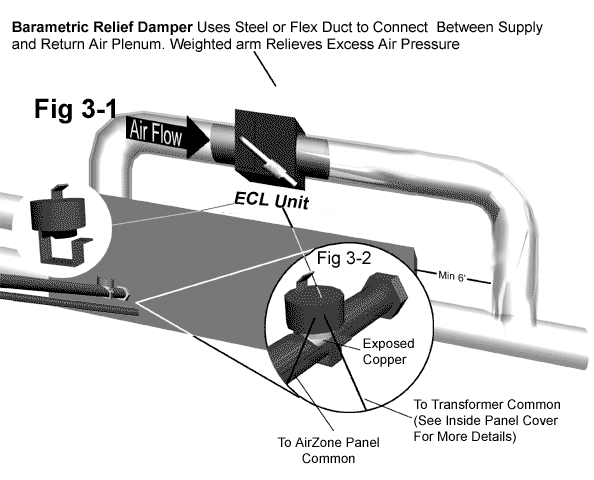
Copyright RetroZone inc.2012
SECTION 3 Static Pressure Control
SECTION 3 STATIC PRESSURE RELIEF SYSTEMS FOR ALL RETROZONE ENERGY SAVING SYSTEMS
Forward: To maintain reliable and efficient operation of the HVAC System, airflow through the internal heat exchanger and air conditioning coil of the HVAC system must not be substantially reduced!
As zones are closed, static pressure will rise, forcing more air out fewer ducts and registers. At the point the pressure rises above the rating of the fan, airflow can become substantially reduced, or noise at the register can increase to an unacceptable level and reduces energy savings.
While problems are rare, restricting too much airflow must be avoided. Retrozone provides a series of industry accepted, reliable devices and techniques to avoid any problems.
STEPS TO TAKE TO INSURE TROUBLE-FREE OPERATION.
The best way to proceed is to measure total system airflow with various airflow instruments with all zones open, and then go back and measure individual zones to compare airflows. If this is not practical, proceed with the steps below:
1. Follow "Typical Static Pressure Guidelines" below.
2. Install an ECL switch on all systems except heat pumps. Install duct sensors (for hi/lo protection) with zone panels that accept their connections.
3. Monitor the HVAC system closely to insure none of the problems described in "Systems and Effects" section.
4. Modify the zoning system as described in "Solutions" section if problems are encountered.
1. TYPICAL STATIC PRESSURE GUIDELINES
2 and 3 Zone retrofit: When the ducts are evenly divided, 2 zone retrofit and often 3 zone retrofit jobs can be accomplished with no static pressure relief system. The use of an ECL switch is always recommended. 3 zone retrofits may benefit from dump zones (see dump zone.)
2 or 3 Zone New Construction: Upsize ducts according to design guide specs, and no pressure relief system should be needed.
4 zone or more, residential: Use an ECL and a barometric relief damper, or consult factory.
4 zone or more, commercial: Use an ECL, barometric relief damper or static pressure system if over 5 tons, or consult factory.
Heat Pumps, All: Extra care must be taken since the ECL switch will not work on a heat pump. Use Hi/lo sensor switches with selected control panels.
NOTE 1: On borderline installations, it is typically very easy to add a static pressure relief system or dump zone AFTER the Retrozone system is installed, and if a problem with too much airflow reduction is encountered.
2. Install Evaporator Coil Limit Switch - See Fig 3-2 and ECL switch installation sheet for more information. The ECL switch is designed to break the common wire from the transformer or control panel to the solenoid air switches. The effect is to defeat all zoning and restore total airflow to the system. The ECL is not designed to control the compressor.
The ECL switch is a safety only. If activated by low suction line temperature, action should be taken to determine the cause (dirty filters, clogged coils, too little zone duct capacity, etc.)
NOTE: The ECL can be falsely triggered by cold ambient temperatures, although this is rare. Insulate the ECL switch if ambient conditions are likely to fall below 38ºF.

Fig 3-1 3-2
3. Symptoms and Effects of too much airflow reduction.
SYMPTOMS:
Described below are some of the immediate symptoms if too much airflow is reduced:
1. Fan "whining" or changing pitch
2. Duct fittings coming loose
3. Air Conditioning Evaporator Coil freezing over with ice
4. Furnace high limit shutting furnace down.
5. Compressor shutting down on safeties
EFFECTS:
Described below are the effects of airflow reduction on the HVAC equipment. These type of problems are extremely rare, but can be caused by restricting too much airflow through the HVAC equipment:
The HVAC Blower fan: If too much airflow is restricted, a typical squirrel-cage type blower will usually begin to freewheel, and actually use less electricity. Zoning poses little or no threat to the fan, although the fan can overheat if airflow is totally blocked.
The HVAC Air Conditioning Coil and Compressor - While rarely a problem, if too much airflow is restricted for too long, moisture can begin to collect and freeze on the inside evaporator coil, eventually shutting down airflow. This can cause refrigerant to return to the compressor as a liquid instead of a gas, which can cause damage. (The ECL switch is great, low cost protection. See ECL switch). Even when too much airflow is reduced, the one zone calling for air will usually satisfy quickly, long before any problem develops.
The HVAC Heat Exchanger - less sensitive than the compressor is the Heat Exchanger. However, caution should be exercised so that the high limit safety switch on the furnace is not activated by restricting too much airflow.
4. SOLUTIONS IF TOO MUCH AIR FLOW REDUCTION IS SUSPECTED.
ALSO USEFUL FOR REDUCING AIR NOISE
A. Create Dump Zone
B. Evaporator Coil Limit Switch
C. Zone Redesign
D. Barometric Relief Damper
E. Static Pressure Control System
A. CREATING A DUMP ZONE: Remove a Flexdamper from a duct that serves a non-critical area that can be over conditioned without causing comfort problems. For instance, a Flexdamper serving a hallway would be a good candidate.
If possible. locate the dump zone close to a return air register. BE SURE to plug the air tube of the removed Flexdamper for proper operation.
B. EVAPORATER COIL LIMIT SWITCH (ECL Switch): Recommended for all systems except heat pumps. The ECL switch deflates all Flexdampers by breaking the 24vac "common" to the solenoids. NOTE: Any energy saving Airzone solenoid can have the vacuum and pressure tube reversed to create a normally closed switch. Using the ECL switch with a "normally open" air solenoid can cause the Flexdamper to inflate when the 24vac common is broken – avoid ECL Switch use in these applications. See Section 4 - Solenoids for more information.
The ECL switch (see fig. 3-2) mounts on the suction line close to the HVAC evaporator coil. The ECL contacts open at approximately 38ºF and do not reset until around 52ºF.
The ECL switch is effective against coil icing caused by reduced airflow from too aggressive zoning. Many other HVAC system problems can cause coil icing, such as dirty filters, coils, or improper refrigerant charge. HVAC equipment must be kept in good working order.
A sometimes-activating ECL switch can be hard to diagnose; and is usually indicated by areas that are getting airflow even when the thermostat is not calling.
An ECL switch is a safety device only, and should never activate in a properly designed system. If the ECL switch is activating, immediately take corrective actions.
C. ZONE REDESIGN - Sometimes, depending on the application, it may be possible to increase the duct capacity of a smaller problem zone by adding to it a duct from a larger zone. With Flexdampers, this can be done simply by disconnecting and re-connecting Flexdampers to different zones, where it can be done. Remember, the capacity of a duct has to do with both its size AND length. Longer ducts have more friction, and can carry less air. Also, the number of turns a duct makes will reduce capacity and energy savings.
Another way to increase airflow is to increase the duct size, or add a second duct to an area, although this is often not practical.
D. BAROMETRIC RELIEF DAMPER - This industry accepted method of controlling static air pressure uses a weighted metal damper to divert air back to the supply air side of the HVAC unit as static air pressure increases. As a result, a single zone receiving air gets less air overall, but that air will be cooler or warmer, which will satisfy the zone faster, therefore, saving energy.
Generally speaking, do not bypass anymore air than is necessary to:
- Protect the HVAC equipment
- Reduce noise to acceptable levels.
Where to use: 5 ton (62,000 btu) units or smaller.
Adjusting the Barometric Relief Damper:
After the Zoning system is installed, adjust all thermostats to call so that all zone Flexdampers are open. Then adjust the weights on the Barometric Relief Damper so that the blade just closes. As zones are then closed, the blade should open and bypass air.
E. STATIC PRESSURE CONTROL SYSTEM
(Fig 3-3) Similar to the
Barometric Relief Damper, the Static Pressure Control System bypasses the exact amount of needed air from the supply plenum to the return plenum.
Where to use: HVAC systems over 5 tons
This system uses pressure sensing switches to modulate the bypass damper to the exact position needed to assure precision airflow and static pressure throughout the HVAC system. Has a pressure set point range of .17 to 2” W.C. Unit is pre-wired at factory and includes damper, probe and sensing tube. See below for needed sizes. Complete hook-up instructions are included with each system.

Fig 3-3
TONNAGE OF RECOMMENDED DAMPER SIZES
HVAC UNIT Rectangular Round
3 – 3.5 12” x 8” 10”
4 – 5 12” x 12” 12”
7.5 – 10 14” x 12” 14”
12.5 18” x 12” 16”
15 – 17.5 24” x 12” 18”
Larger sizes available along with intermediate sizes. Call Factory for details. Round dampers can handle up to 3” W.C.
Copyright RetroZone 2013












